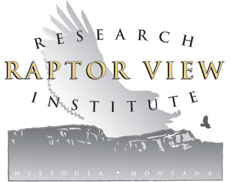* Adult Golden Eagle Satellite Tracking Study
* Determining Gender
* Wing-loading Project
* Eagle Lead Project
* Watch a capture video
Tracking device
Adult Golden Eagle Satellite Tracking Study
Compared to young Golden Eagles, adults are far less studied on migration with satellite telemetry. This is largely due to the difficulty of capturing wary adults. We can learn more about Golden Eagle migratory ecology as a whole by studying adults, as they are proven survivors and have completed their migratory journeys many times over.![]()
Where do they winter and how long do they stay? Do they use the same migration routes and wintering areas annually? What are the major causes of mortality, both human related and naturally occurring? These are just some of the questions that we need to answer in order to determine appropriate conservation and management strategies. To help answer some of these difficult questions, we have
partnered with Bryan Bedrosian with Craighead-Beringia South and Melanie Smith GIS analyst with
Audubon Alaska.
Click to see a map of our
two eagle's movements.
Long-term point count surveys of migrating Golden Eagles on the Rocky Mountain Front flyway (RMF) indicate declines in both total fall and spring Golden Eagle annual counts over the past 15 years and suggest the rate of decline has been increasing. This trend is more pronounced in the spring point count totals and may be due, in part, to an increase in mortalities occurring on wintering grounds in the Lower 48. In order to slow Golden Eagle population declines, it is imperative to understand the current fall and spring migration routes, stopover areas, winter range movement patterns, and potential hazards within these areas.
Threats to migrating eagles in the form of power line electrocution, poisoning, shooting, lead contamination due to fragmented rifle bullets in carrion and gut piles, vehicle collisions, habitat degradation and others have been ongoing for many years. Indeed, threats to Golden Eagles have clearly increased and may have reached the point where reproduction is unable to keep up with increasing mortality.
Personnel: Adult Golden Eagle Satellite Tracking Project: Rob Domenech, Executive Director RVRI, Bryan Bedrosian M.S., and Melanie Smith M.S.
See maps to check out the migration routes of a few of our satellite
tracked adults Golden Eagles
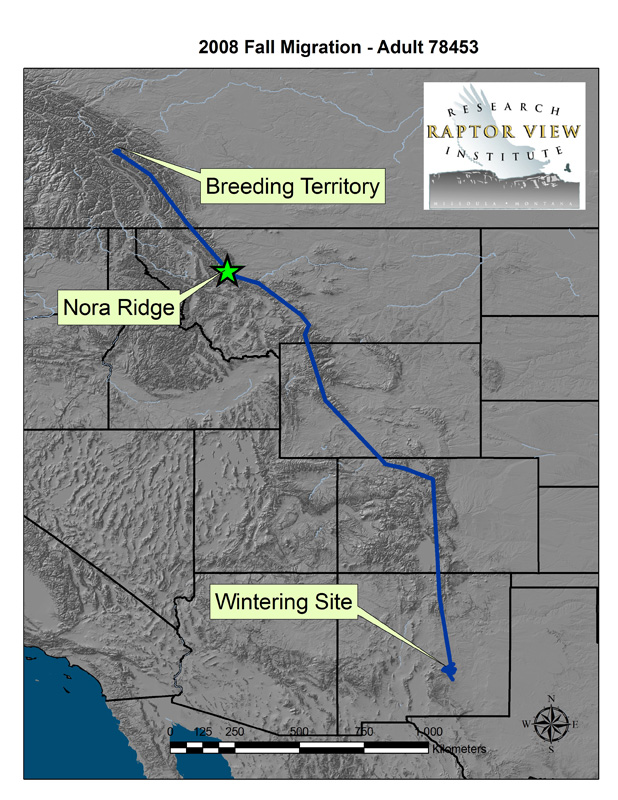 Click to enlarge |
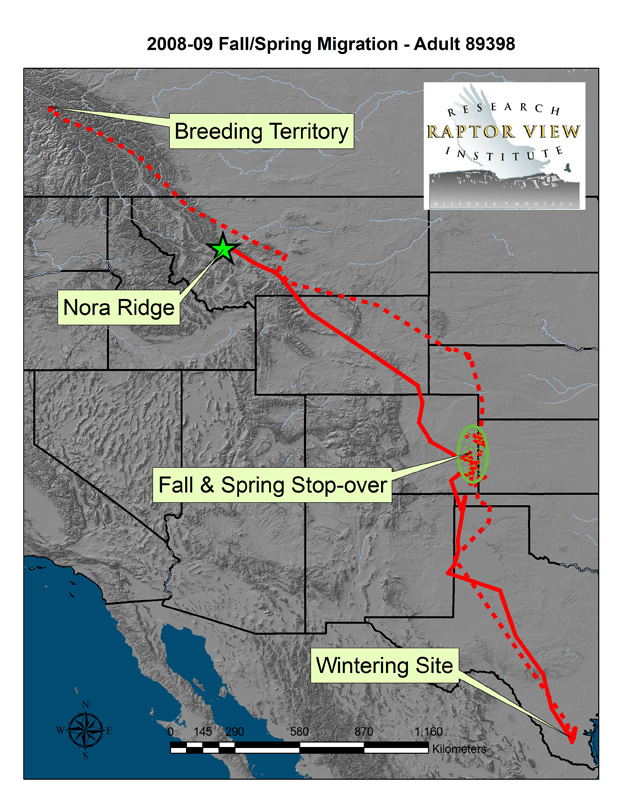 Click to enlarge |
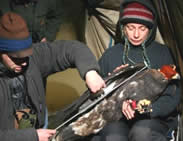 Determining Gender in Golden Eagles
Determining Gender in Golden Eagles
Morphological measurements such as, wing-chord, tail length, body weight, etc., have proven to be reliable indicators in determining gender for several raptor species. In many raptors, females are often measurably larger than males. However, this is not always the case with golden eagles. By collecting DNA and comparing it to our morphological measurements, we hope identify the most accurate technique for sexing golden eagles in hand.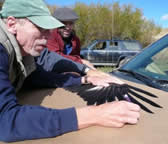 Wing-loading Project
Wing-loading Project
In general to determine wing-loading, we utilize wing area and body mass measurements. Wing-loading is known in many species of raptors, but not in golden eagles. This research will add insight into golden eagle aerodynamics and behavioral ecology.
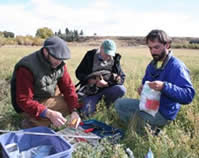 Eagle Lead Project
Eagle Lead Project
Lead poisoning in raptors, especially bald eagles has been well documented. A ban on lead shot for waterfowl hunting was initiated in 1991 to remedy this problem. However, colleague Bryan Bedrosian with Beringia South regularly detects elevated blood-lead levels in ravens and bald eagles, from the on-set and shortly after rifle hunting season. Evidence suggests that the contamination may be coming from gut piles.
Like ravens, golden eagles are opportunistic feeders, known to scavenge gut piles. This fall we collected blood from 35 golden eagles. These samples are currently being analyzed for lead by University of Montana chemist Heiko Langner. Preliminary data, using a portable lead test kit reveled elevated lead levels in nine of seventeen birds tested in the field.
Fall Migrating Golden Eagle Lead Project
Lead has long been documented as a serious environmental hazard to eagles and other predatory, opportunistic and scavenging avian species. Due to lead poisoning in the Bald Eagle, Golden Eagles and numerous waterfowl species, the use of lead shot for waterfowl hunting on federal and state lands was banned in 1991.
More recently, lead poisoning from spent ammunition has been identified as the leading cause of death in California Condors, prompting the recent ban of lead ammunition within the “California Condor Recovery Zone.” Research on Common Ravens in Wyoming, headed up by Bryan Bedrosian and Derek Craighead with Craighead-Beringia South, Wyoming has shown a direct correlation between elevated blood-lead levels and the on-set of rifle hunting season. This and other evidence suggests the source of the continued contamination is coming from gut (offal) piles left behind by hunters.
It was though our conversations with Bedrosian that we started testing for lead as part of our fall migration ecology work on Golden eagles.
To date we have lab analyzed blood from 92 Golden Eagles and have found that nearly 50% of our sampled eagles had elevated blood-lead levels. We surmise the use of lead-core ammunition for hunting is likely the major source for lead exposure in Golden Eagles, though we cannot pinpoint a particular source species or specific region. This is in part due to the overlapping timing of hunting seasons for various game species in different regions of the Rocky Mountains and the very large area inhabited by Golden Eagles during migration season.
Although at this time it is impossible to show, if our preliminary numbers are representative of the northern migratory population of Golden Eagles as whole, we could be looking at a serious threat to the species on a landscape level. We feel that an intensive educational outreach campaign and/or a complete switch away from lead-containing ammunition to alternative less toxic materials for game hunting is the only alternative to protect these and other scavenging species, including human consumers.
Personnel: Robert Domenech, Executive Director RVRI and Dr. Heiko Langner, Geochemistry Lab University of Montana
Recent Raptor View Publication:
Blood Lead Levels of Fall Migrant Golden Eagles in West-Central Montana (PDF, 120kb)
Related Resources and Publications:
A Relationship Between Blood Lead Levels of Common Ravens and The Hunting Season in the Southern Yellowstone Ecosystem (PDF , 216kb)
The Peregrine Fund December 2009 Fact Sheet on Lead Exposure from Spent Ammunition (PDF , 108kb)
Exposure of California Condors to Lead From Spent Ammunition (PDF , 112kb)
Proceedings Ingestion of Lead Ammunition: Implications for Wildlife and Humans Conference
https://www.peregrinefund.org/lead_conference/2008PbConf_Proceedings.htm
Minnesota DNR Lead Information for Hunters
http://www.dnr.state.mn.us/hunting/lead/index.html
